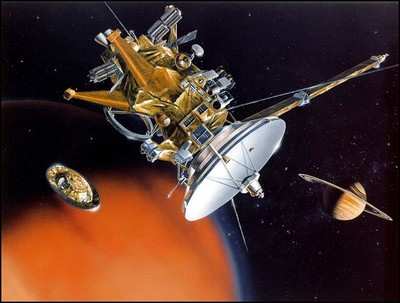Building Blocks Of Life On Hyperion?
NASA's Cassini spacecraft has revealed for the first time
surface details of Saturn's moon Hyperion, including cup-like
craters filled with hydrocarbons that may indicate more widespread
presence in our solar system of basic chemicals necessary for
life.

Hyperion yielded some of its secrets to the battery of
instruments aboard Cassini as the spacecraft flew close by in
September 2005. Water and carbon dioxide ices were found, as well
as dark material that fits the spectral profile of
hydrocarbons.
A paper appearing in the July 5 issue of Nature reports details
of Hyperion's surface craters and composition observed during this
flyby, including keys to understanding the moon's origin and
evolution over 4.5 billion years. This is the first time scientists
were able to map the surface material on Hyperion.
"Of special interest is the presence on Hyperion of hydrocarbons
-- combinations of carbon and hydrogen atoms that are found in
comets, meteorites, and the dust in our galaxy," said Dale
Cruikshank, a planetary scientist at NASA's Ames Research Center in
California, and the paper's lead author. "These molecules, when
embedded in ice and exposed to ultraviolet light, form new
molecules of biological significance. This doesn't mean that we
have found life, but it is a further indication that the basic
chemistry needed for life is widespread in the universe."
Cassini's ultraviolet imaging spectrograph and visual and
infrared mapping spectrometer captured compositional variations in
Hyperion's surface. These instruments, capable of mapping mineral
and chemical features of the moon, sent back data confirming the
presence of frozen water found by earlier ground-based
observations, but also discovered solid carbon dioxide (dry ice)
mixed in unexpected ways with the ordinary ice.
Images of the brightest regions of Hyperion's surface show
frozen water that is crystalline in form, like that found on
Earth.
"Most of Hyperion's surface ice is a mix of frozen water and
organic dust, but carbon dioxide ice is also prominent. The carbon
dioxide is not pure, but is somehow chemically attached to other
molecules," explained Cruikshank.
 Prior
spacecraft data from other moons of Saturn, as well as Jupiter's
moons Ganymede and Callisto, suggest that the carbon dioxide
molecule is "complexed," or attached with other surface material in
multiple ways. "We think that ordinary carbon dioxide will
evaporate from Saturn's moons over long periods of time," said
Cruikshank, "but it appears to be much more stable when it is
attached to other molecules."
Prior
spacecraft data from other moons of Saturn, as well as Jupiter's
moons Ganymede and Callisto, suggest that the carbon dioxide
molecule is "complexed," or attached with other surface material in
multiple ways. "We think that ordinary carbon dioxide will
evaporate from Saturn's moons over long periods of time," said
Cruikshank, "but it appears to be much more stable when it is
attached to other molecules."
"The Hyperion flyby was a fine example of Cassini's
multi-wavelength capabilities. In this first-ever ultraviolet
observation of Hyperion, the detection of water ice tells us about
compositional differences of this bizarre body," said Amanda
Hendrix, Cassini scientist on the ultraviolet imaging spectrograph
at NASA's Jet Propulsion Laboratory, Pasadena, Calif.
Hyperion, Saturn's eighth largest moon, has a chaotic spin and
orbits Saturn every 21 days.
The Cassini-Huygens mission is a cooperative project of NASA,
the European Space Agency and the Italian Space Agency. JPL, a
division of the California Institute of Technology in Pasadena,
manages the Cassini-Huygens mission for NASA's Science Mission
Directorate, Washington.
 ANN's Daily Aero-Term (05.01.24): Say Altitude
ANN's Daily Aero-Term (05.01.24): Say Altitude ANN's Daily Aero-Linx (05.01.24)
ANN's Daily Aero-Linx (05.01.24) Classic Aero-TV: Korean War Hero Twice Reborn
Classic Aero-TV: Korean War Hero Twice Reborn Airborne 04.29.24: EAA B-25 Rides, Textron 2024, G700 Deliveries
Airborne 04.29.24: EAA B-25 Rides, Textron 2024, G700 Deliveries Airborne Affordable Flyers 05.02.24: Bobby Bailey, SPRG Report Cards, Skydive!
Airborne Affordable Flyers 05.02.24: Bobby Bailey, SPRG Report Cards, Skydive!




